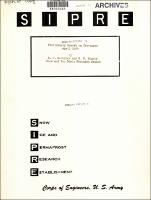Please use this identifier to cite or link to this item:
https://hdl.handle.net/11681/23153| Title: | Preliminary report on crevasses |
| Authors: | Schuster, Robert L. Rigsby, George P. |
| Keywords: | Glaciers |
| Publisher: | U.S. Army Snow, Ice, and Permafrost Research Establishment. |
| Series/Report no.: | Special Report;11 |
| Abstract: | A crevasse is a deep crevice or fissure in the snow or ice of a glacier. Crevasses are formed by tensional. forces which exceed the breaking strength of the snow or ice. These tensional forces are usually due to differential movement within the glacier. Crevasses may be divided into several types based on their position and orientation. The most common of these is the transverse crevasse, which occurs at right angles to the direction of flow of a glacier. Also common is the longitudinal crevasse, which parallels the flow. The radial crevasse is a kind of longitudinal crevasse which occurs where the flow of the glacier becomes less constricted and the glacier spreads out laterally. Radial crevasses are prominent near the snouts of "expanded foot'' glaciers. Marginal crevasses, which occur along the edges of valley glaciers, are also common. They point diagonally upstream toward the centers of the glaciers at angles approximating 45°. Any of the above types may be rotated slightly from its original orientation by the flow of the glacier. Often two or more types of crevasses will intersect each other, creating a rnultiple crevasse system with intersecting patterns. Another type of crevasse that may be encountered on valley glaciers is the bergschrund. Bergschrunds are generally formed near the valley wall by the moving ice (includes ice and/or snow) pulling away from the stationary ice anchored to the rock of the wall. Since the glacier moves down as well as away, the upper lip of a bergschrund is generally higher than the lower, making crossing difficult. |
| URI: | http://hdl.handle.net/11681/23153 |
| Appears in Collections: | Special Report |
Files in This Item:
| File | Description | Size | Format | |
|---|---|---|---|---|
| SIPRE Special Report 11.pdf | 668.97 kB | Adobe PDF |  View/Open |